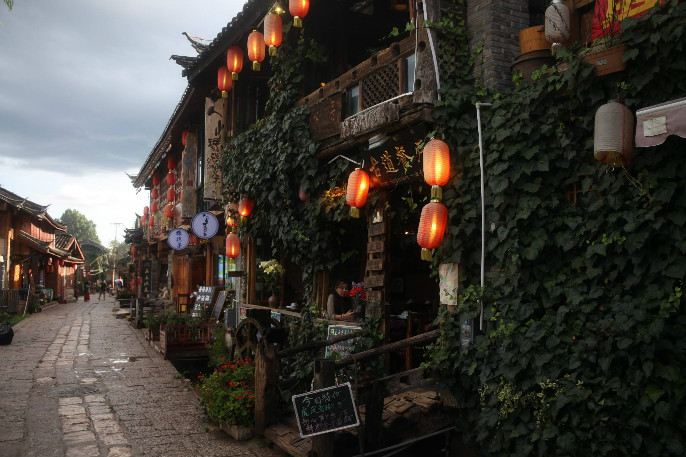
Shuhe in the dialect of Naxi ethnic minority is called “Shaowu” meaning “a village at the foot a lofty peak”. It’s 4 kilometers away from the Old Town of Lijiang, at the foot of Jade Dragon Snow Mountain.
As one of the habitats of the Naxi ancestors in Lijiang area, Shuhe Old Town used to function as an important dak on the Ancient Tea and Horse Trail (Road). The prosperous trades along the Tea and Horse Trail made various necessities sell quite well. In the Ming Dynasty, Chieftain Mu of Lijiang managed to employ from Jiangnan Area (China’s south part of Yangtze; i.e. Zhejiang and Jiangsu provinces, etc) a great number of craftsmen who settled down in Suhe to make it (Shuhe) a famous “Cobblers’ Village”. Products then were mainly leather shoes, saddle, fur clothing, iron wares and so on. Shuhe Old Town is one of the oldest habitats of Lijiang and well-preserved town on the Ancient Tea Route (茶马古道) showing the history of Naxi ethnic minority group from farming centralization to commercial centralization.
The Slate-paved streets, beautiful old wooden and stone buildings with traditional Naxi-style upturned eaves create a peaceful and charming atmosphere that is often considerably more relaxed than that found in the more heavily trafficked Dayan (more generally referred to as Lijiang Old Town).
Shuhe is known for “the eight famous sights” and Tea-Horse Trail Museum etc.
The eight sights
(1)- Willow Waves over the Bridge (Yan Liu Ping Qiao)
As the designing work of Chieftain Mu and with its axis facing Jubao Mountain, Qinglong (Blue Dragon) Bridge was originally constructed in the Wanli Period thus is over 400 years old. As a total masonry work, it is 25 meters long, 4.5 meters wide and 4 meters high. The bridge was also a landmark of Lijiang when Mu’s Power was in its hey day. In spring, when the willows around the bridge begin to sprout up, they vividly look like green waves and smokes that are trying to ascend over the bridge, which is referred to as “Yan Liu Ping Qiao” (smoke-like willow waves over the bridge).
(2)-Night Market with “Fir Bugs” (Ye Shi Ying Huo)
Though only 30 meters long and much smaller than the Sifang (Square) Street in Dayan Town (Lijiang Old Town), Suhe’s Square Street used to be one of the earliest markets in Lijiang Basin. In old times night market was arranged on the street for residents to go shopping relaxingly. At that time, people had to hold lanterns for illumination on the banks of Qinglong River thus another view was formed:“Ye Shi Ying Huo”(the night market with “fire bugs”)
(3)-Jiuding Dragon Pool (four sights)
Situated at the foot of Longquan Mountain, Jiuding Dragon Pool has limpid water and lots of carp. The highlight of the pool is Sanshenggong Temple composed of Guanyin (Goddess of Mercy) Shrine, King Dragon Shrine, and Sun Bin Shrine (Sun Bin is the Great Master of Cobblers) and another pavilion with cloisters as viewing stands. There are four sights with Jiuding Dragon Pool: Reflection of the Snow-capped Mountain; Stone steles; Carps; and the Moon.
(4)- Night school in Shilian Temple (“Shi Lian Ye Du”)
In the south part of Suhe West Mountain is a village called “Songyun Village” behind which is Shilian Hill. A tiger-mouth-like cave is facing the village, which is traditionally considered to be ominous. In order to vanquish the “tiger”, the villagers constructed a temple inside the cave-Shilian Temple. In the period of Republic of China, a night school was once established in the cave and students used to study in the candles-lit classrooms.
(5)- Red Leaves On the West Mountain (Xi Shan Hong Ye)
The West Mountain of Suhe boasts lots of varnish trees that bear red leaves in autumn; so Suhe looks extremely attractive with the mountain as its background.